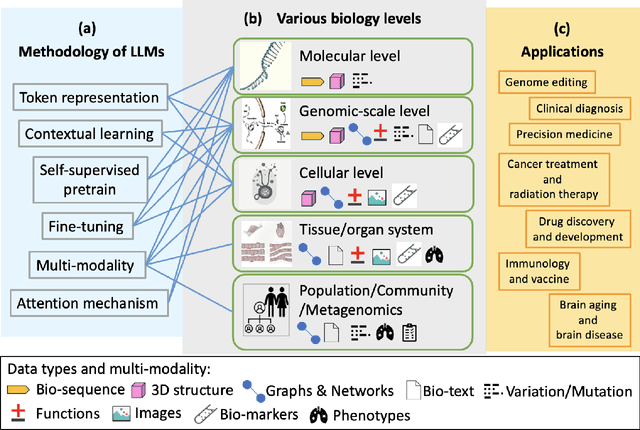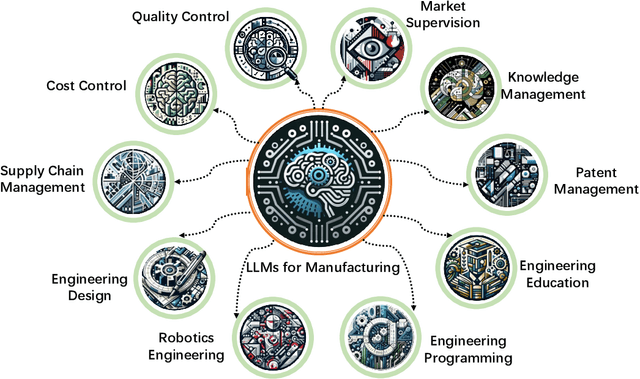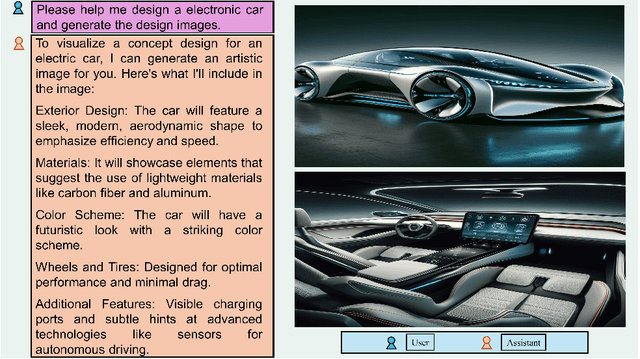Peng Shu
Real-time Ad retrieval via LLM-generative Commercial Intention for Sponsored Search Advertising
Apr 02, 2025Abstract:The integration of Large Language Models (LLMs) with retrieval systems has shown promising potential in retrieving documents (docs) or advertisements (ads) for a given query. Existing LLM-based retrieval methods generate numeric or content-based DocIDs to retrieve docs/ads. However, the one-to-few mapping between numeric IDs and docs, along with the time-consuming content extraction, leads to semantic inefficiency and limits scalability in large-scale corpora. In this paper, we propose the Real-time Ad REtrieval (RARE) framework, which leverages LLM-generated text called Commercial Intentions (CIs) as an intermediate semantic representation to directly retrieve ads for queries in real-time. These CIs are generated by a customized LLM injected with commercial knowledge, enhancing its domain relevance. Each CI corresponds to multiple ads, yielding a lightweight and scalable set of CIs. RARE has been implemented in a real-world online system, handling daily search volumes in the hundreds of millions. The online implementation has yielded significant benefits: a 5.04% increase in consumption, a 6.37% rise in Gross Merchandise Volume (GMV), a 1.28% enhancement in click-through rate (CTR) and a 5.29% increase in shallow conversions. Extensive offline experiments show RARE's superiority over ten competitive baselines in four major categories.
Target-driven Self-Distillation for Partial Observed Trajectories Forecasting
Jan 28, 2025Abstract:Accurate prediction of future trajectories of traffic agents is essential for ensuring safe autonomous driving. However, partially observed trajectories can significantly degrade the performance of even state-of-the-art models. Previous approaches often rely on knowledge distillation to transfer features from fully observed trajectories to partially observed ones. This involves firstly training a fully observed model and then using a distillation process to create the final model. While effective, they require multi-stage training, making the training process very expensive. Moreover, knowledge distillation can lead to a performance degradation of the model. In this paper, we introduce a Target-driven Self-Distillation method (TSD) for motion forecasting. Our method leverages predicted accurate targets to guide the model in making predictions under partial observation conditions. By employing self-distillation, the model learns from the feature distributions of both fully observed and partially observed trajectories during a single end-to-end training process. This enhances the model's ability to predict motion accurately in both fully observed and partially observed scenarios. We evaluate our method on multiple datasets and state-of-the-art motion forecasting models. Extensive experimental results demonstrate that our approach achieves significant performance improvements in both settings. To facilitate further research, we will release our code and model checkpoints.
Fine-Tuning Open-Source Large Language Models to Improve Their Performance on Radiation Oncology Tasks: A Feasibility Study to Investigate Their Potential Clinical Applications in Radiation Oncology
Jan 28, 2025



Abstract:Background: The radiation oncology clinical practice involves many steps relying on the dynamic interplay of abundant text data. Large language models have displayed remarkable capabilities in processing complex text information. But their direct applications in specific fields like radiation oncology remain underexplored. Purpose: This study aims to investigate whether fine-tuning LLMs with domain knowledge can improve the performance on Task (1) treatment regimen generation, Task (2) treatment modality selection (photon, proton, electron, or brachytherapy), and Task (3) ICD-10 code prediction in radiation oncology. Methods: Data for 15,724 patient cases were extracted. Cases where patients had a single diagnostic record, and a clearly identifiable primary treatment plan were selected for preprocessing and manual annotation to have 7,903 cases of the patient diagnosis, treatment plan, treatment modality, and ICD-10 code. Each case was used to construct a pair consisting of patient diagnostics details and an answer (treatment regimen, treatment modality, or ICD-10 code respectively) for the supervised fine-tuning of these three tasks. Open source LLaMA2-7B and Mistral-7B models were utilized for the fine-tuning with the Low-Rank Approximations method. Accuracy and ROUGE-1 score were reported for the fine-tuned models and original models. Clinical evaluation was performed on Task (1) by radiation oncologists, while precision, recall, and F-1 score were evaluated for Task (2) and (3). One-sided Wilcoxon signed-rank tests were used to statistically analyze the results. Results: Fine-tuned LLMs outperformed original LLMs across all tasks with p-value <= 0.001. Clinical evaluation demonstrated that over 60% of the fine-tuned LLMs-generated treatment regimens were clinically acceptable. Precision, recall, and F1-score showed improved performance of fine-tuned LLMs.
Large Language Models for Bioinformatics
Jan 10, 2025
Abstract:With the rapid advancements in large language model (LLM) technology and the emergence of bioinformatics-specific language models (BioLMs), there is a growing need for a comprehensive analysis of the current landscape, computational characteristics, and diverse applications. This survey aims to address this need by providing a thorough review of BioLMs, focusing on their evolution, classification, and distinguishing features, alongside a detailed examination of training methodologies, datasets, and evaluation frameworks. We explore the wide-ranging applications of BioLMs in critical areas such as disease diagnosis, drug discovery, and vaccine development, highlighting their impact and transformative potential in bioinformatics. We identify key challenges and limitations inherent in BioLMs, including data privacy and security concerns, interpretability issues, biases in training data and model outputs, and domain adaptation complexities. Finally, we highlight emerging trends and future directions, offering valuable insights to guide researchers and clinicians toward advancing BioLMs for increasingly sophisticated biological and clinical applications.
QueEn: A Large Language Model for Quechua-English Translation
Dec 06, 2024

Abstract:Recent studies show that large language models (LLMs) are powerful tools for working with natural language, bringing advances in many areas of computational linguistics. However, these models face challenges when applied to low-resource languages due to limited training data and difficulty in understanding cultural nuances. In this paper, we propose QueEn, a novel approach for Quechua-English translation that combines Retrieval-Augmented Generation (RAG) with parameter-efficient fine-tuning techniques. Our method leverages external linguistic resources through RAG and uses Low-Rank Adaptation (LoRA) for efficient model adaptation. Experimental results show that our approach substantially exceeds baseline models, with a BLEU score of 17.6 compared to 1.5 for standard GPT models. The integration of RAG with fine-tuning allows our system to address the challenges of low-resource language translation while maintaining computational efficiency. This work contributes to the broader goal of preserving endangered languages through advanced language technologies.
OracleSage: Towards Unified Visual-Linguistic Understanding of Oracle Bone Scripts through Cross-Modal Knowledge Fusion
Nov 26, 2024



Abstract:Oracle bone script (OBS), as China's earliest mature writing system, present significant challenges in automatic recognition due to their complex pictographic structures and divergence from modern Chinese characters. We introduce OracleSage, a novel cross-modal framework that integrates hierarchical visual understanding with graph-based semantic reasoning. Specifically, we propose (1) a Hierarchical Visual-Semantic Understanding module that enables multi-granularity feature extraction through progressive fine-tuning of LLaVA's visual backbone, (2) a Graph-based Semantic Reasoning Framework that captures relationships between visual components and semantic concepts through dynamic message passing, and (3) OracleSem, a semantically enriched OBS dataset with comprehensive pictographic and semantic annotations. Experimental results demonstrate that OracleSage significantly outperforms state-of-the-art vision-language models. This research establishes a new paradigm for ancient text interpretation while providing valuable technical support for archaeological studies.
Transcending Language Boundaries: Harnessing LLMs for Low-Resource Language Translation
Nov 18, 2024



Abstract:Large Language Models (LLMs) have demonstrated remarkable success across a wide range of tasks and domains. However, their performance in low-resource language translation, particularly when translating into these languages, remains underexplored. This gap poses significant challenges, as linguistic barriers hinder the cultural preservation and development of minority communities. To address this issue, this paper introduces a novel retrieval-based method that enhances translation quality for low-resource languages by focusing on key terms, which involves translating keywords and retrieving corresponding examples from existing data. To evaluate the effectiveness of this method, we conducted experiments translating from English into three low-resource languages: Cherokee, a critically endangered indigenous language of North America; Tibetan, a historically and culturally significant language in Asia; and Manchu, a language with few remaining speakers. Our comparison with the zero-shot performance of GPT-4o and LLaMA 3.1 405B, highlights the significant challenges these models face when translating into low-resource languages. In contrast, our retrieval-based method shows promise in improving both word-level accuracy and overall semantic understanding by leveraging existing resources more effectively.
Legal Evalutions and Challenges of Large Language Models
Nov 15, 2024



Abstract:In this paper, we review legal testing methods based on Large Language Models (LLMs), using the OPENAI o1 model as a case study to evaluate the performance of large models in applying legal provisions. We compare current state-of-the-art LLMs, including open-source, closed-source, and legal-specific models trained specifically for the legal domain. Systematic tests are conducted on English and Chinese legal cases, and the results are analyzed in depth. Through systematic testing of legal cases from common law systems and China, this paper explores the strengths and weaknesses of LLMs in understanding and applying legal texts, reasoning through legal issues, and predicting judgments. The experimental results highlight both the potential and limitations of LLMs in legal applications, particularly in terms of challenges related to the interpretation of legal language and the accuracy of legal reasoning. Finally, the paper provides a comprehensive analysis of the advantages and disadvantages of various types of models, offering valuable insights and references for the future application of AI in the legal field.
Large Language Models for Manufacturing
Oct 28, 2024



Abstract:The rapid advances in Large Language Models (LLMs) have the potential to transform manufacturing industry, offering new opportunities to optimize processes, improve efficiency, and drive innovation. This paper provides a comprehensive exploration of the integration of LLMs into the manufacturing domain, focusing on their potential to automate and enhance various aspects of manufacturing, from product design and development to quality control, supply chain optimization, and talent management. Through extensive evaluations across multiple manufacturing tasks, we demonstrate the remarkable capabilities of state-of-the-art LLMs, such as GPT-4V, in understanding and executing complex instructions, extracting valuable insights from vast amounts of data, and facilitating knowledge sharing. We also delve into the transformative potential of LLMs in reshaping manufacturing education, automating coding processes, enhancing robot control systems, and enabling the creation of immersive, data-rich virtual environments through the industrial metaverse. By highlighting the practical applications and emerging use cases of LLMs in manufacturing, this paper aims to provide a valuable resource for professionals, researchers, and decision-makers seeking to harness the power of these technologies to address real-world challenges, drive operational excellence, and unlock sustainable growth in an increasingly competitive landscape.
Retrieval Instead of Fine-tuning: A Retrieval-based Parameter Ensemble for Zero-shot Learning
Oct 13, 2024



Abstract:Foundation models have become a cornerstone in deep learning, with techniques like Low-Rank Adaptation (LoRA) offering efficient fine-tuning of large models. Similarly, methods such as Retrieval-Augmented Generation (RAG), which leverage vectorized databases, have further improved model performance by grounding outputs in external information. While these approaches have demonstrated notable success, they often require extensive training or labeled data, which can limit their adaptability in resource-constrained environments. To address these challenges, we introduce Retrieval-based Parameter Ensemble (RPE), a new method that creates a vectorized database of LoRAs, enabling efficient retrieval and application of model adaptations to new tasks. RPE minimizes the need for extensive training and eliminates the requirement for labeled data, making it particularly effective for zero-shot learning. Additionally, RPE is well-suited for privacy-sensitive domains like healthcare, as it modifies model parameters without accessing raw data. When applied to tasks such as medical report generation and image segmentation, RPE not only proved effective but also surpassed supervised fine-tuning methods in certain cases, highlighting its potential to enhance both computational efficiency and privacy in deep learning applications.
 Add to Chrome
Add to Chrome Add to Firefox
Add to Firefox Add to Edge
Add to Edge